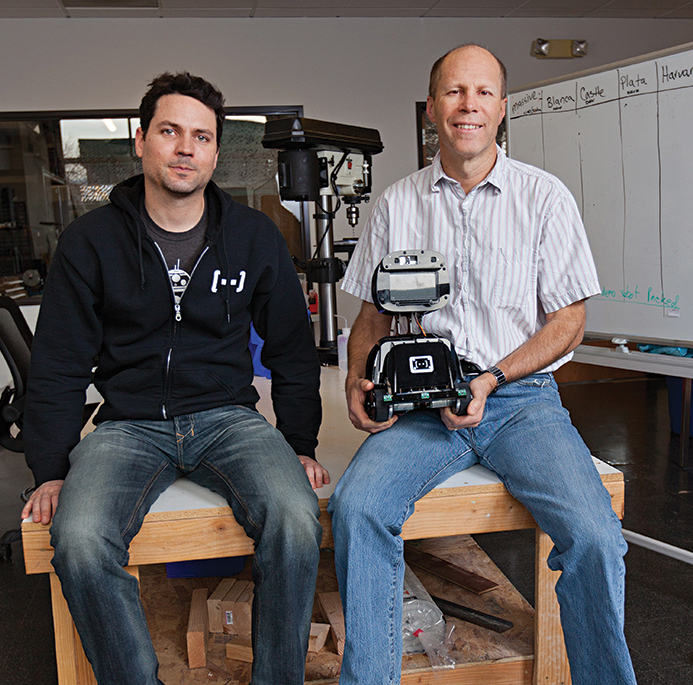Tech Startup: Sphero Spinoff Crafts Functional Consumer Robots
Misty Robotics' 10-year plan calls for about three years in an “inventor phase”
Eric Peterson //April 5, 2018//


Tech Startup: Sphero Spinoff Crafts Functional Consumer Robots
Misty Robotics' 10-year plan calls for about three years in an “inventor phase”
Eric Peterson //April 5, 2018//
MISTY ROBOTICS
WHERE: Boulder
FOUNDED: 2017
INITIAL LIGHT BULB
Founder and Head of Product Ian Bernstein also started Sphero, the Boulder toymaker that made the rolling BB-8 robot for the “Star Wars” franchise.
With a vision of a more utilitarian robot for every home and office, Bernstein reached out to Tim Enwall, formerly CEO of Revolv and Tendril Networks, to help raise capital and guide the new company. “I absolutely fell in love with Ian,” Enwall says. “He’s a genius.”
As Enwall joined as CEO, Sphero spun Misty Robotics off as a separate company in June 2017. “Mostly that was about focus,” Enwall says. “Sphero is really about connected play. They needed to devote all of their capital and leadership to connected play.”
IN A NUTSHELL
Misty Robotics is developing functional robots for the home and workplace that can be programmed by non-coders in about 30 minutes.
While many specifics remain under wraps, the company’s 10-year plan calls for about three years in an “inventor phase,” followed by early adoption in years four through six, and then “more mass-market environments” by 2027, Enwall says.
The Misty I robot shipped to a select list of developers in February. “It’s a prototype that went out to a few dozen hardcore developers who are really into robotics,” Enwall says.
The Misty II will hit the broader market by the end of 2018; the retail price has yet to be determined. The Misty I units were made in Boulder, but the Misty II will be manufactured by Jetta, the same company that makes Sphero’s products in China. Enwall says Bernstein has an “incredible relationship” with Jetta. “They’ve produced 3 million robots for Sphero,” he says. “It’s an incredible advantage for a company like Misty.
“There are still a lot of challenges with building this robot,” Enwall says, with “both digital and physics problems to solve.” Artificial intelligence has a ways to go, as does grasping and manipulation robotics, at least within the consumer price point.
Enwall also points to integrating depth-mapping technology from Boulder-based Occipital, an industry first for robotics, to allow for autonomous mobility. Not only does it involve a complex technological challenge from an engineering and design standpoint, but it also involves “navigating home environments from plush carpeting to concrete,” Enwall says. “You’ve got to overcome socks, extension cords and various things on the ground.”
THE MARKET
Enwall says early uses might involve security, elder care and “greeting and guiding,” but emphasizes that users will largely determine what Misty’s robots are best at.
“Our whole hypothesis is that there are millions of programmers out there who have dreamed of programming a robot and have never been able to,” he says. “If you look at the dawn of the web and you asked, ‘What are the uses?’ the answer was, ‘Nobody knows.’ That’s the case here. Developers have never been able to access an easy-to-program robot.
“The ideas are just rampant,” he adds, and highlights a developer working on a program to make a guide for conferences. On “the whimsy side,” participants in a late 2017 hackathon developed “synchronized robots” and are now set on producing a soap opera starring Misty’s robots.
Enwall says that taller robots, outdoor-ready robots, and other iterations will follow the initial release. “We’ll have different models of robots,” he says.
FINANCING
An investment group led by Venrock and Foundry Group staked Misty Robotics with $11.5 million in a Series A financing round when the company spun off from Sphero. “We’re pretty well set,” Enwall says. “We’re 100 percent focused on solving some technological problems and getting a product on the market and getting our hypothesis validated.”

























